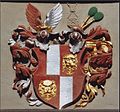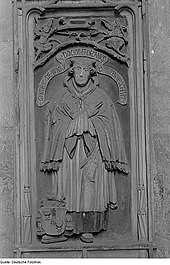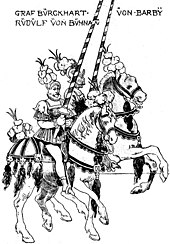Bünau
The von Bünau family is an old and geographically widespread German aristocratic family that owned properties in Electoral Saxony , the Thuringian states , Old Prussia , Old Württemberg and Bohemia .
history

The von Bünau family belongs to the ancient Naumburg nobility. As eponymous places are discussed Beuna , today a district of Merseburg , Bonau , today a district of Teuchern , and Büna , today a district of the town of Zeulenroda-Triebes in the district of Greiz .
Their oldest verifiable family members served as ministerials among the bishops of the diocese of Naumburg . Rudolfus de Bunowe , castellan of Schönburg Castle in this diocese, was mentioned in a document on March 10, 1166 as the first family member. At that time, the Bünaus owned several hooves as fiefdoms in Köttichau, among others , of which on January 17, 1206 Berthold II. On behalf of Günther von Bünau transferred two hooves to the St. Stephan monastery in Zeitz , whose daughter was to be accepted there as a nun .
In the following decades, von Bünaus also appeared as burgraves and bailiffs in the Vogtland , before the aristocratic family branched out and spread out geographically from the High Middle Ages onwards as a result of natural development. Through the acquisition of numerous goods and dominions, the family branched out over the centuries into 15 main and 28 secondary lines. Despite or precisely because of this broad diversification, the von Bünaus teams tried, not least for economic reasons, to appear closed to the outside world. To this end, regular meetings and consultations between male family members have taken place since 1507. The agreements made here have become known as the Family Act . They mainly regulated questions of property law and established, among other things, the habits to be followed at events, marriages and deaths.
Compared to other noble families, the von Bünaus families stand out particularly through the choice of the first names of their male family members. According to legend, 200 descendants of the family died in the Hussite Wars (1420–1434). Only three brothers or - this is questionable - cousins named Heinrich, Günther and Rudolf survived the atrocities of war. In your memory, all male descendants should only have one of the three first names. The truth of this tradition is not known. The fact is, however, that the von Bünaus actually decided, through an inheritance in 1517, to give male members only one of the three first names. It is conceivable that the unity of the family should also be externally documented with the uniform choice of name.
coat of arms
The existence of a Bünau coat of arms with a leopard's head and lily can be proven for the first time in 1301. The four-part coat of arms, which is still in use today, was first used in 1487. Since 1495 it has shown a red and silver split shield in the first and fourth fields, and a gold lion mask with a lily in the throat in the second and third field. The decorations were added later.
The Bünau coat of arms above the castle gate in Weesenstein
The coat of arms of those of Bünau above the church door of Geising
Dominions and possessions (selection)
- Reign of Weesenstein : 1406–1772
- Reign of Liebstadt : 1410–1691 ( Kuckuckstein Castle )
- Rödern manor : 1413–1444
- Reign of Lauenstein : 1517–1823
- Reign of Eulau (Jílové u Děčína): 1527–1629
- Reign of Blankenstein (Blansko): 1527–1628
- Rule of Decin ( Decin ): 1534-1628
- Reign of Schönstein / Königswald ( Libouchec ): 1534 (?) - 1628 (?)
- Schön Prießen Castle ( Krásné Březno - Ústí nad Labem ): 1594–1606
- Giessenstein hammer mill : 1579–1663
- Rule of Büg in Middle Franconia: 1611–1791
- Prossen Manor : 1630–1678
- Pillnitz Manor : 1633–1694
- Lichtenwalde Castle : 1694–1719
- Zusendorf : 1739–1758
- Nöthnitz Castle : 1739–1762
- Dahlen Castle : 1721–1851
- Seusslitz Castle : 1722–1799
- Oberstadt Castle : around 1800–1826
other goods in today's Burgenlandkreis (Saxony-Anhalt) and Leipzig (Saxony):
- Braunsdorf with Bedra (1413–1460?), Boblas (1413-?), Castle Droy says (1413–1622), Freiroda (? -?), Teuchern (? -?) With Gröbitz (before 1278-after 1575), the Rudelsburg with Vorwerk Kreipitzsch (1441–1581), Meyhen , Plotha , Ramsdorf (1600–1682), Schleenhain , Schkölen , Stoß , Wildenhain , Zscheiplitz , Bischheim and others
Lauenstein Castle
Known family members
- Christiane Wilhelmine von Bünau (1666–1707), since 1692 wife of Duke Johann Adolf I of Saxe-Weissenfels
- Günther von Bünau (Bishop) , Bishop of Samland 1505–1518
- Günther von Bünau (Canon) († 1519), German theologian and dean of the cathedral
- Günther von Bünau (1557–1619) , Lord of Lauenstein (Altenberg)
- Günther von Bünau (Major General) (1843–1926), German Major General
- Günther von Bünau (judge) (1844–1899), German judge
- Heinrich von Bünau (Chamberlain, 1656) (1656–1729), German Chamberlain and governor
- Heinrich von Bünau († 1744) , German manor owner and court official
- Heinrich von Bünau (1665–1745) , German civil servant
- Heinrich von Bünau (historian) (1697–1762), German statesman and historian
- Heinrich von Bünau (district councilor) (before 1701–1772), German district councilor and war commissioner
- Heinrich von Bünau (Chamberlain, 1732) (1732–1768), German Chamberlain
- Heinrich von Bünau (General, 1778) (1778–1834), German major general
- Heinrich von Bünau (General, 1789) (1789–1864), German major general
- Heinrich von Bünau (General, 1850) (1850–1919), German major general
- Heinrich von Bünau (General, 1873) (1873–1943), German infantry general and SS Oberführer
- Heinrich von Bünau (politician) (1906-1992), German politician (FDP)
- Rudolph von Bünau (the provider) (1593–1647), German nobleman and court official, member of the Fruit Bringing Society
- Rudolph von Bünau (Lieutenant Colonel) (1604–1640), German Lieutenant Colonel
- Rudolph von Bünau (the sociable) (1613–1673), German nobleman and court official, member of the Fruit Bringing Society
- Rudolph von Bünau (governor) (1659–1709), German governor and colonel
- Rudolph von Bünau (Chamberlain) (1711–1772), German Chamberlain and Canon
- Rudolf von Bünau (1547-1622) , German nobleman
- Rudolf von Bünau, the Elder (1603–1634), German nobleman
- Rudolf von Bünau (General, 1762) (1762–1841), German major general
- Rudolf von Bünau (politician) (1804–1866), German manor owner and politician
- Rudolf von Bünau (General, 1852) (1852–1911), German Lieutenant General
- Rudolf von Bünau (General, 1890) (1890–1962), German infantry general
literature
- anonymous: Of the well-praised sex, whose imperial counts and lords of Bünau clock-old and renovated in 1650th sex order. ( Digitized version )
- Max Julius Büttner: Chronicle of the old mountain town of Lauenstein together with a history of the castle and its owners and a description of the church and its art treasures. Leipzig 1902.
- Iniciativa pro decinsky zamek (ed.): The Lords of Bünau in Saxony and Bohemia. Decin 2006, ISBN 80-239-6852-1 .
- Martin Wittig: The gentlemen from Bünau on Weesenstein. Social and economic conditions of a Saxon noble family in the 16th and 17th centuries. In: Communications of the Association for Saxon State History. Issue 1/2003, pp. 7-20.
- Martina Schattkowsky (Ed.): The von Bünau family. Aristocratic rule in Saxony and Bohemia from the Middle Ages to modern times (= writings on Saxon history and folklore, volume 27). Leipzig 2008.
- Valentin König : Genealogical nobility calendar. Volume 2: Genealogical aristocratic history or gender description of the noble families in Chur-Saxon and neighboring countries. Leipzig 1729, pp. 200-288 ( full text ).
- Maria Emanuel Duke of Saxony : Patronage in Saxony , Verlag Weidlich, Frankfurt am Main 1968, pp. 12-14, 31, 42
- History of the Upper Lusatian Nobility and their Goods, III. Department. / The noble families , Bünau, also counts, p.219ff
- Gothaisches genealogical pocket book of noble houses 1903, p.221ff
Web links
- Family website of those from Bünau
- Literature and information on the von Bünau in the Wildenfels castle archive
Individual evidence
- ↑ Martina Schattkowsky: The von Bünau family. Aristocratic rule in Saxony and Bohemia from the Middle Ages to modern times. Leipziger Universitätsverlag, 2008, p. 136.
- ↑ cf. Iniciativa pro decinsky zamek 2006; According to other information, the first family meeting did not take place until 1508 (cf. http://www.von-buenau.de/ [August 11, 2006])
- ↑ cf. Iniciativa pro decinsky zamek 2006; According to other information, the three baptismal names have only been used since the first appearance of the gender (cf. http://www.von-buenau.de/ [11 August 2006])











